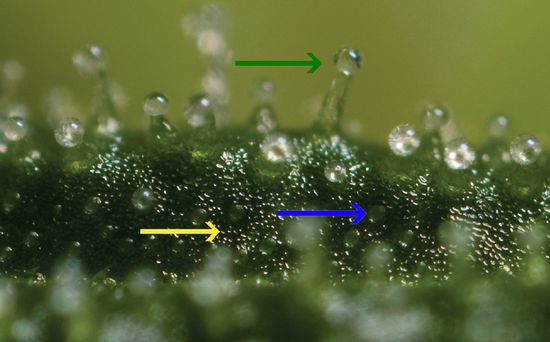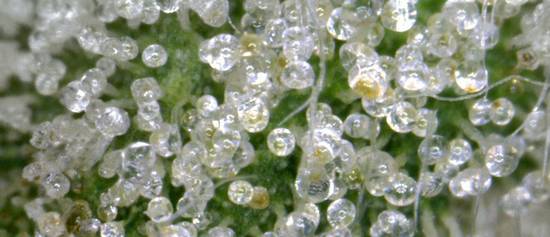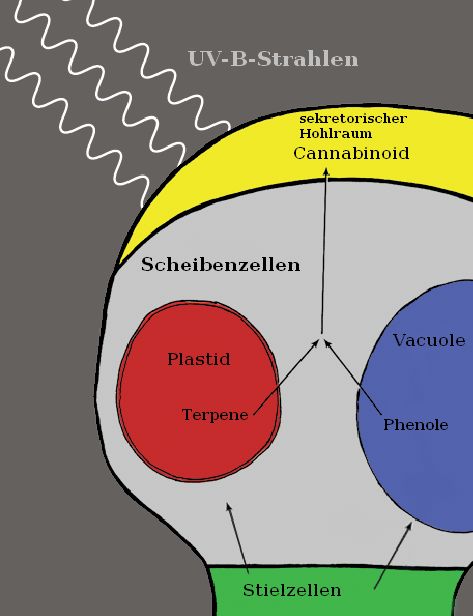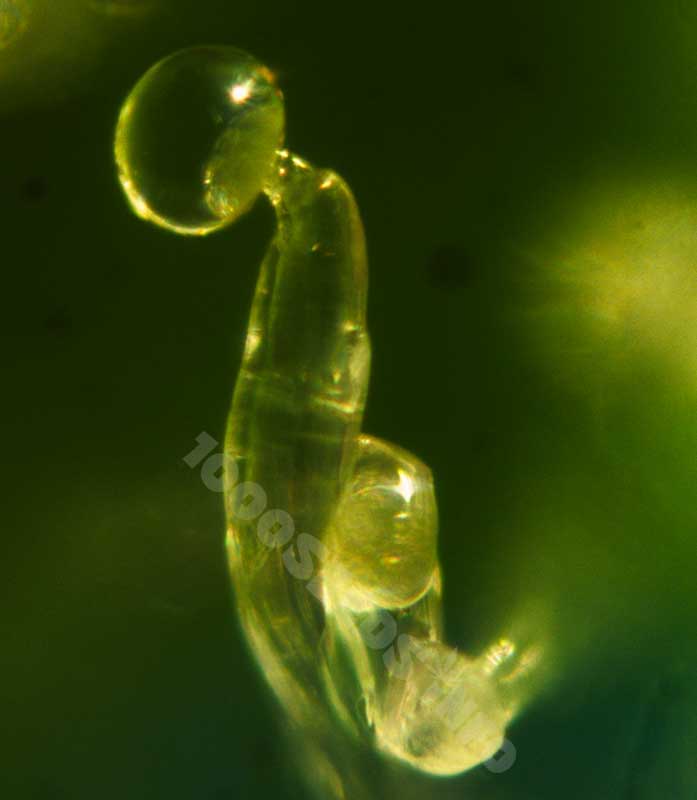Every grower and cannabis lover's heart swells at the sight of the flowers and leaves sparkling in the light. What most people know is that this glitter is caused by the many fine hairs, called trichomes, and that the cannabinoids, such as THC or CBD, are contained in the resinous coating of these trichomes. What is less known is why the cannabis plants form these trichomes and what their biological purpose is. So it's time to take a closer look.
In biology, the thesis prevails that cannabis plants produce trichomes as a defence mechanism against potential enemies. The word trichome comes from the Greek and means something like "growth of hairs". They serve as a protective shield in the evolution of the plant genus against dangers from the environment, thus ensuring its further development. The sticky hairs, which grow on just about the entire plant, form a protective layer against the attack of insects and prevent them from penetrating to the plant surface. The chemicals in the trichomes make cannabis less palatable to hungry animals and they also inhibit the growth of some types of fungi. The resin also helps protect the plants from excessive wind and low humidity, acting like a natural sunshade and blocking UV-B rays. Since the trichomes contain the euphoric properties of cannabis, the resin became especially attractive to us humans. Humans have had the greatest influence in cannabis evolution by breeding and selecting plants with greater resin production.
The different types of trichomes
Trichomes grow in numerous shapes and sizes on many types of plants. The cannabis plant develops 3 main types:

Tuber trichomes:
This type is the smallest (15 to 30 microns). One to four cells form the "foot" and "stalk" and another 1-4 cells form the "head" of the gland. The head of these trichomes contains cannabinoids and related compounds, when the plant is mature a small nipple forms on the head due to pressure. The bulb glands are scattered over the entire surface of the above-ground parts of the plant.
Trichomes with head, without stalk (capitate sessile):
The second type of trichome is larger (25 to 100 micrometres) and more numerous than the bulbous glands. They have a spherical star-shaped head and only one stalk, invisible under the spherical head, consisting of one cell. The head is usually composed of eight cells, but may consist of up to 16 cells forming a convex rosette. They contain few cannabinoids and related compounds.
Trichomes with head and stalk (Capitate-Stalked):
Cannabinoids are most abundant in the stalked head glands, which consists of a series of secretory disc cells and a large non-cellular secretory cavity. During the flowering phase, mainly this third type of resin gland is formed. Some of these trichomes develop stalks up to 150-500µm long. This type of trichome grows mainly on the female bracts (the leaves that protect the seeds) and on the small petals. Male cannabis plants produce only a few of these glands with lower potency.

Cannabinoids
Cannabinoids are a group of chemical compounds that occur naturally in the cannabis plant and were first discovered in the 1940s. When consumed by humans, they dock onto CB1 and CB2 cannabinoid receptors in the brain and body, triggering euphoria and other effects. The broad definition includes three types: phytocannabinoids, which are uniquely found in the cannabis plant; endogenous cannabinoids, which are produced in the bodies of humans and other mammals, birds, fish and reptiles; and synthetic cannabinoids, compounds produced synthetically in the laboratory. For more on the topic of cannabinoids, see here
Inside the trichomes

THC and other cannabinoids are only produced in one place on the cannabis plant: in the heads of the trichomes. This happens in the following way: The cannabis plant produces organelles, on the one hand the so-called vacuoles [blue], which contain phenols , a chemical compound similar to alcohol, and on the other hand the so-called plastids [red], which contain terpenes. These make their way from the stalk [green] to the head and mix in the secretory cavity to form a fibrous coating [yellow]. This concentrated coating is hit by UV-B light waves and thus changes into the cannabinoids. Since all psychoactive ingredients of cannabis are produced in the trichomes, these hairs are exactly what is needed to produce concentrates and hashish.
Potency and trichomes
It is not necessarily the case that a plant with more trichomes has greater potency. Rather, it depends on how potent the resin is. And this in turn depends on the composition with the individual cannabinoids. This makes a comprehensive potency measurement of cannabis impossible, because different amounts of cannabinoids cause different effects. Only the content of the individual cannabinoids can be determined, which does not necessarily say anything about the "strength" of the cannabis.
[fblike style="standard" showfaces="false" width="450″ verb="like" font="arial"] [fbshare type="button"] [google_plusone size="standard" annotation="none" language="English (UK)"]







